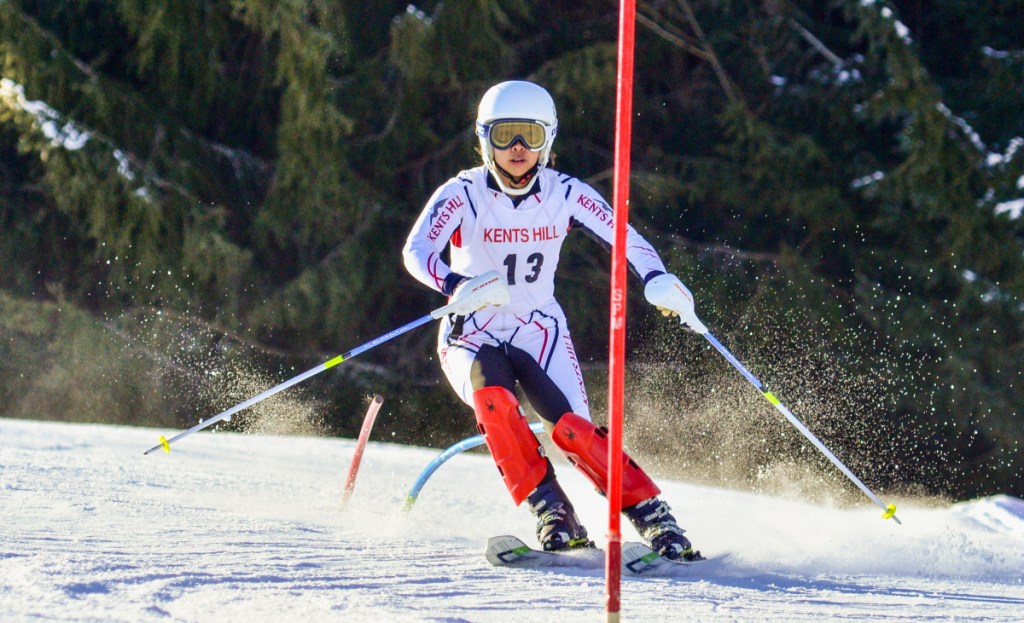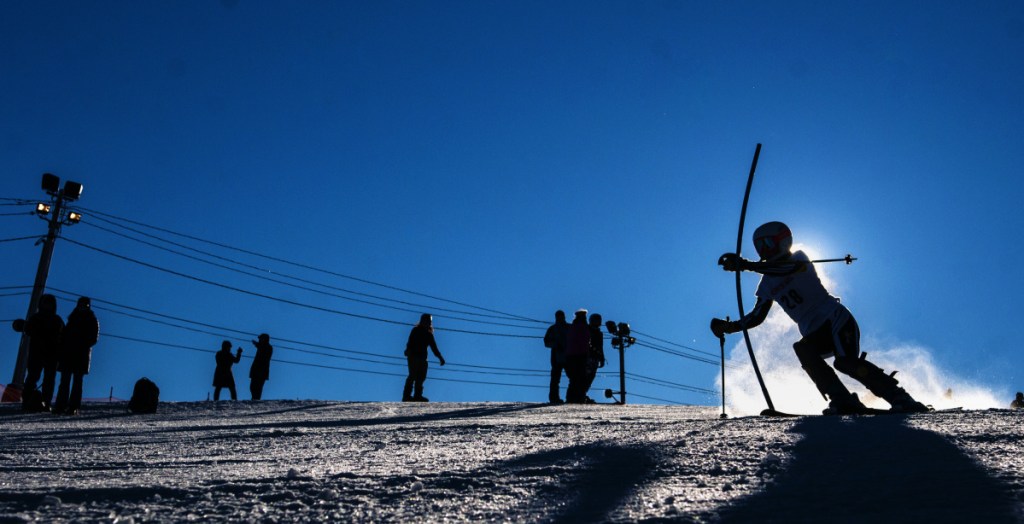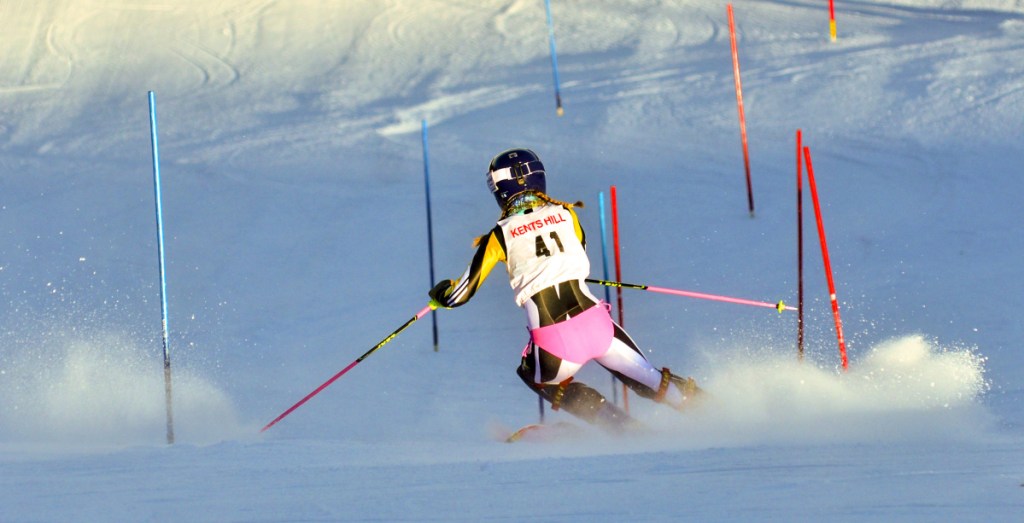READFIELD — It was the largest field in the Marlee Johnston Memorial Ski Race’s history, and the 180-plus skiers that showed up at Kents Hill School’s O’Connor Alpine Center had mid-teen temperatures and single-digit wind chills waiting for them.
And to think. That wasn’t even that bad.
“This isn’t cold,” Maranacook coach Ronn Gifford said. “This is nice.”
Ski racing in Maine, however, means running into those days that make even the toughest folks on the slope tense up with each gust of wind, and leave them plotting out the quickest route back to the warmth and comfort of the lodge.
Saturday may not have been one of those days. But everyone in the sport knows it’s a matter of time before they come around.
“When you can see your breath as soon as it comes out of your mouth, it’s cold,” Winthrop’s Maguire Anuszewski said. “And when you get inside and it hurts to breathe, that’s another of those times that (you know) it’s cold.
“What can you say? It’s Maine.”
Saturday wasn’t a cinch. Temperatures were 13 degrees by the time the high school races started at 1:30 p.m., and the wind chill was hovering at 3 degrees. Skiers kept their jackets on a little longer than they normally would between races, and made a little bit more of an effort to warm up before their runs than they might otherwise.
“Today’s definitely a cold day compared to this race in years past,” Spruce Mountain’s Julia Pomeroy said. “You’ve just got to keep moving, because if you stop moving, everything starts to hurt.”
But it could have been worse. The race was moved up from the morning to the afternoon in anticipation of frigid temperatures, and Kents Hill coach Steve Bell said temperatures were down to zero in the morning. But the stiff wind let up by late morning, and the conditions at the hill became surprisingly ideal.
“You really want it this way,” Bell said. “The snow conditions are so much better, you can groom it better, it stays firm but not too icy. If it gets warm, cold, warm, cold, you get polished snow. You end up wanting it to be more like this.”
It just needs to get a little colder than Saturday, however, for those rave reviews to turn into horror stories. Pomeroy dealt with it just the day before at Titcomb, when a 4 p.m. start time and large field meant taking evening runs on a windy night that saw temperatures fall to zero degrees and wind chills drop into the negatives.
“You really just have to wear your layers, and when you get to the top and you take your stuff off to race, you’ve got to keep moving,” she said. “We train even at night when the sun goes down, and the cold days get even worse than that.”
Kents Hill’s Anna Laberge, a Readfield resident, endured those conditions while racing at Sunday River.
“It was negative-1 with wind chills. It was freezing,” she said. “Yesterday was the worst I’ve ever seen.”
Anuszewski and Maranacook’s Robbie McKee cast their vote for a race last year at Mt. Abram, which saw temperatures in single digits with a 20 mile-per-hour wind.
“Oh my God, it was brutal,” McKee said. “It was dark and cold, and super windy. The key is just kind of staying positive there.”
“I think there were two racers before me. I took off my snow pants and as soon as I did, my legs were just freezing,” Anuszewski said. “It’s a bit of a struggle to stay warm on those days.”
When it’s that cold, there’s a two-pronged approach to tackling the weather. Mentally, the cold has to be nothing. Physically, it has to be everything.
“You’ve got to block the cold out. Everybody’s got to deal with it,” Gifford said. “And then physically, you need to get yourself prepared. You’ve got to take those 10, 15 minutes before you’re actually going to race and start stretching, start doing calisthenics and doing some drills to get yourself hot and as warm as you can get.”
Preparation means everything, from hot food to warm clothes to constant stretching.
“All of the above,” Bell said. “You do a lot less coaching. You do a lot more moving down and getting them their coats.”
And when that fails, skiers can improvise.
“I think, personally, the thing that keeps me the warmest is staying hyped out here,” McKee said. “Kind of cheering on everyone and screaming and yelling, and moving around.”
Still, in icy weather, coaches have to be prepared for when all those precautions aren’t enough.
“You’re not only looking at the course and the conditions and all that, but you’re starting to look at faces, making sure they’re covered,” Bell said. “Numerous times we’ve had to pull kids off the hill with white spots on their ear lobe or their cheeks. You really have to kind of watch them, because they don’t see that.”
If they’re properly outfitted, however, Bell said the cold can be good.
“For these guys, this really is part of the deal,” he said. “They want to be out there doing this.”
Those skiers he was referring to feel the same way.
“Last night we all wanted to go inside and be done with it,” Pomeroy said. “But it really does set people apart, who wants to be out there racing and who’s really out there because someone else wants them to do it. If you really love racing and you really want to be out there doing it, you’ll do everything you can to work past the cold.”
Drew Bonifant — 621-5638
dbonifant@centralmaine.com
Twitter: @dbonifantMTM
Send questions/comments to the editors.






Comments are no longer available on this story